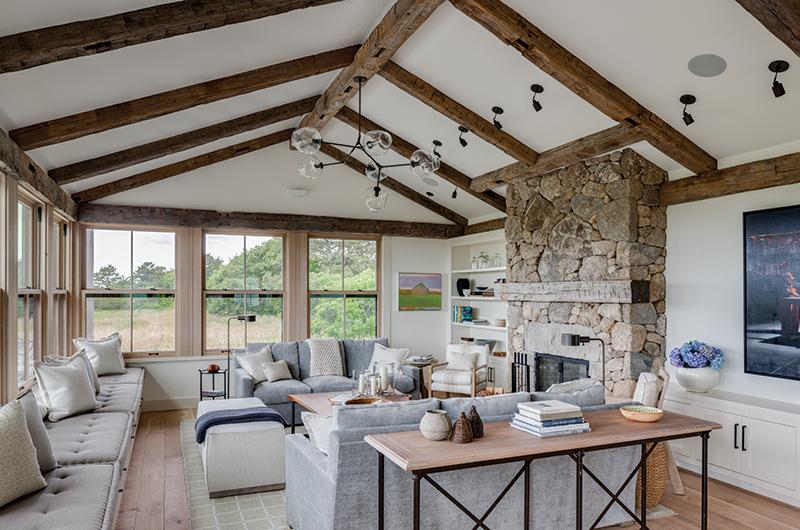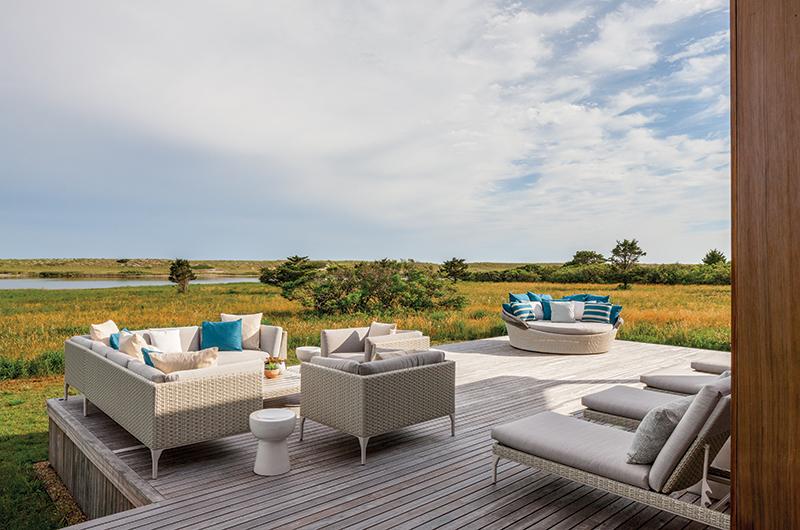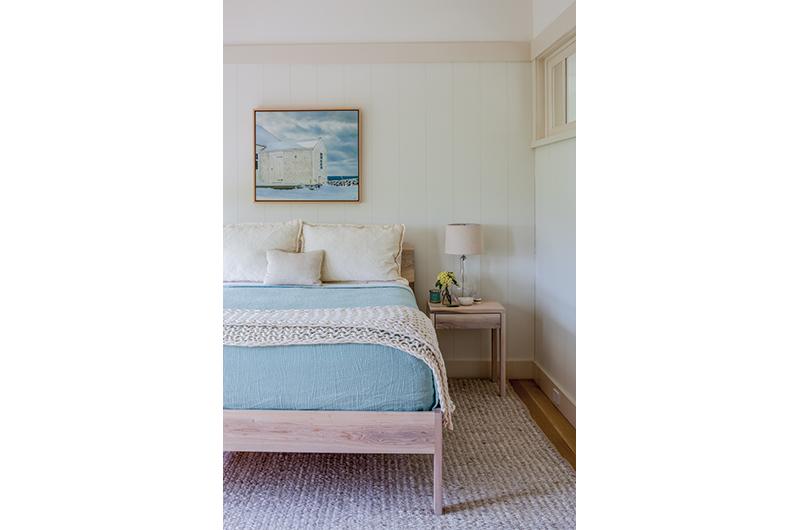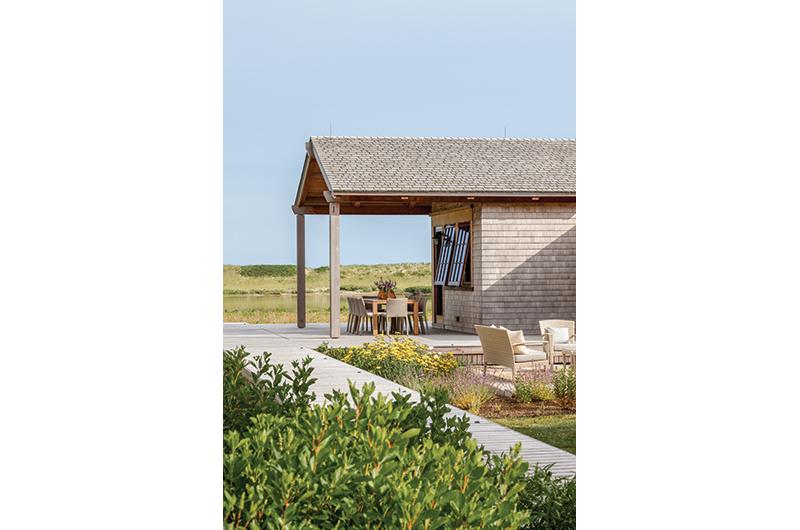When Richard Kauffman and Ellen Jewett sat down with Phil Regan and Greg Ehrman of Hutker Architects, they got right to the point. “What would you do with this property?” they asked.
Kauffman and Jewett had rented on Abel’s Hill in Chilmark for their family vacations for years, always with a casual eye toward the real estate market, but had never found a spot that clicked until a narrow Chilmark Pond waterfront lot at the end of a dirt road with two dilapidated houses and a garage hit the market. They bought it sight unseen from their home in New York City.

Put on the spot, Regan replied honestly, and with a response he also hoped would be what the new homeowners wanted to hear. “I’d recreate the campy feeling,” he said, and then spoke of the natural beauty of the site and the need to respect it, work with it, settle into it. That must have been the right answer; soon Regan and Ehrman were on site determining whether the three existing structures were salvageable. After deciding they were not, the design process commenced.
Kauffman and Jewett see themselves not just as homeowners but as stewards of the land, so early on in the process they enlisted environmental consulting firm the Woods Hole Group to survey the property and help guide their design approach. Upon completing a historic survey analysis of the changing shoreline that dated back to the late 1800s, the Woods Hole Group predicted that a future home on the site could sustain around 100 years before the dunes would roll back on it. The priority from that point forward was to design a comfortable home with modern amenities that didn’t compromise the resiliency of the property in the face of climate change. That meant adding a green roof, solar panels, a nitrogen recovery system, and obtaining LEED (Leadership in Energy and Environmental Design) certification. The front yard would return to a meadow.
Because of the proximity to the marsh, the home would also be elevated and accessed via a network of boardwalks. The lifted decks would add to the rustic camp feeling of the property but also disguise their true purpose: flood-proofing the home. Another boardwalk would connect a detached master bedroom to the rest of the house. The Hutker team had proposed the concept to other clients in the past, but Kauffman and Jewett were the first to bite.

They would do all this – build a comfortable, spacious, environmentally minded family home – within the strictures of the Chilmark “big house” bylaw that had recently been passed.
“It was very important to us to show that you can have a great house within the regulations,” said Kauffman. He and Jewett hired Vineyard-based builder Dan Perry of Perry Construction
for the job.
Inside the home one finds a refuge of neutral colors and textiles, exposed timber beams, and local artwork. A long farm-style dining table separates the kitchen and living room. A breakfast nook ties together the kitchen area, while window seats, a plush sofa, and a stone fireplace beg you to snuggle up in the living room. Notably, there is no television in the living space; with the panoramic views of the pond and marsh it is not missed.

Beyond the living space lies a long, narrow hallway, which the family lovingly refers to as The Motel. Out of this corridor juts a bathroom, laundry room, and three bedrooms, each with access to the outdoors and their own distinctive style.
Across the boardwalk, the detached master features a bedroom, bathroom, office, and abundant closet space.
At Hutker’s recommendation, the couple hired Kathleen Walsh, a New York City–based interior designer who specializes in turnkey, but not carbon copy, homes, and often works with clients who convey to her their vision and taste and set her free to execute it. After their first meeting, Walsh understood the couple’s love for the land and desire to create a versatile four-season space that would be as comfortable on a hot August day as a crisp November holiday gathering.

“It’s not like they were going to swap out their sofa with the season; the color scheme would have to work year-round,” she explained. The trick was to find a palette that would work across the seasons. “Some materials scream summer – linen and cotton – but in the dead of winter, those wouldn’t work.”
Walsh pulled heavily from nature to tie the look together, which she joked might sound trite, but pointed out that “we’re talking about the specific nature of this property: evergreen trees, dunes, sand, and marsh.”
Wall colors were kept light and color was sparingly introduced in window casings and door trim, which were painted a shade of rust reminiscent of mid-fall foliage. Walsh wanted the mind to register color without really noticing it.

The artwork was collected by the couple after the house had been completed, which Walsh noted is not typically a designer’s preference.
“We like to know what we’re working with,” she admitted with a laugh, “but if you’re in the mindset of ‘I love that!’ then it’s going to work.” The couple bought primarily from Island artists to create a distinctive American aesthetic.
Another interior design challenge was working with the living room’s many windows. Though abundant windows are an obvious choice for a home with sweeping views of the pond, at night those windows become mirrors – or, worse from a design perspective, black holes. To combat that effect, Walsh looked to furnishings.
“I knew we had to keep the eye engaged, especially at night. And they had to be enduring and practical.”
When all was said and done and the couple spent their first weekend in the home, Walsh waited anxiously to hear from them for the whole weekend, to no avail. Finally, four days later, they contacted her to say that they were so comfortable and relaxed they hadn’t thought to reach out.
They felt as if they had escaped, they told her, which equates to a five-star review for both architects and interior designer, as far as Walsh is concerned.




 2 comments
2 comments
Comments (2)